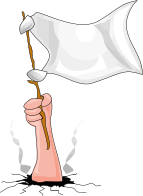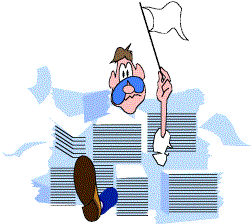Waving the white flag
 Gone are the days when journalists stood on principle. American newspaper editors and ombudsmen scrambled together columns for their publications' weekend editions explaining why they chose not to run images of the cartoons that have resulted in several death threats against journalists. The general consensus, according to my unscientific review, is that they were too offensive. For a more thorough listing of the columns than I will provide, check out Poynter's Romenesko.
Gone are the days when journalists stood on principle. American newspaper editors and ombudsmen scrambled together columns for their publications' weekend editions explaining why they chose not to run images of the cartoons that have resulted in several death threats against journalists. The general consensus, according to my unscientific review, is that they were too offensive. For a more thorough listing of the columns than I will provide, check out Poynter's Romenesko.
My favorite column from the weekend had to have been Tim Rutten over at the Los Angeles Times:
Nothing, however, quite tops the absurdity of two pieces on the situation done this week by the New York Times and CNN. In the former instance, a thoughtful essay by the paper's art critic was illustrated with a 7-year-old reproduction of Chris Ofili's notorious painting of the Virgin Mary smeared with elephant dung. (Apparently, her fans aren't as touchy as Muhammad's.) Thursday, CNN broadcast a story on how common anti-Semitic caricatures are in the Arab press and illustrated it with -- you guessed it -- one virulently anti-Semitic cartoon after another. As the segment concluded, Wolf Blitzer looked into the camera and piously explained that while CNN had decided as a matter of policy not to broadcast any image of Muhammad, telling the story of anti-Semitism in the Arab press required showing those caricatures.
He didn't even blush.
Rutten then ripped into the hypocrisy of American newspapers, using the film version of Dan Brown's novel The Da Vinci Code as an example of how the media will not hesitate to jump all over a movie that distorts a major religion.
It all comes down to the Fatwa, doesn't it? Christians don't issue them, Muslims do.
Certainly, there should be reviews since this is a news event, though it would be a surprise if any of them had something substantive to say about these issues. But what about publishing feature stories, interviews or photographs? Isn't that offensive, since they promote the film? More to the point, should newspapers and television networks refuse to accept advertising for this film since plainly that would be promoting hate speech? Will our editors and executives declare their revulsion at the very thought of profiting from bigotry?
Naaaaww.
News reports over the weekend revealed that certain Arab governments were behind the riots. How despicable is that? They even handed out copies of the cartoons. Now, why in the world would any media organization want to play into that type of strategy by publishing the cartoons, as blogger and columnist Andrew Sullivan insists that they do?
The answer is simple: reporters don't concern themselves with what governments want when publishing content. Sure, publishing the cartoons in the United States would not have exactly calmed the situation in the Middle East and would have played into the hands of those seeking to incite the riots. But does that change the fact that they were legitimate news items that should be published?
As Sullivan said in a column in this week's Sunday Times:
The fundamental job of journalists is to give you as much information as possible to make sense of the world around you.
 An Indianapolis Star column is a great example of the weak thinking going through the minds of the profit-focused leadership of American newspapers. As a longtime reader of that newspaper, I know a thing or two about its tradition of publishing legitimate news (disclaimer: I used to work there. See my bio for more details).
An Indianapolis Star column is a great example of the weak thinking going through the minds of the profit-focused leadership of American newspapers. As a longtime reader of that newspaper, I know a thing or two about its tradition of publishing legitimate news (disclaimer: I used to work there. See my bio for more details).
I was quite disappointed in Dennis Ryerson's explanation for why the cartoons were not published:
Newspapers also have every right to be provocative in a truly free society. Indeed, many readers want us to be just that, so long, that is, as our provocation supports their point of view.
With that right come responsibilities.
The Star shouldn't be in the business of promoting any religion or point of view in its news columns; we need to respect all religions and all views.
But our responsibility also is to avoid intentionally giving offense to a basic tenet of an entire religion, which is just what reprinting the controversial cartoons would do.
The column is fraught with mischaracterizations, starting with the assertion that publishing images of Muhammad violates a basic tenet of Islam -- since when?
Ryerson writes, "It is sadly unfortunate that many people hold the Islamic faith, as opposed to Islamic extremists, as being responsible for world terrorism." Actually, all of Islam is responsible in one way or another for the extremism. It is the responsibility of Muslims to rise up and dispel this myth. Some are thankfully trying.
Few times has the Indianapolis Star held back in publishing things that certain groups in the local community would have found offensive. I remember a highly publicized case of a photo of two women kissing. The newspaper lost 5,000 in subscriptions (ouch for a Gannett publisher). I also remember the publication of photos of barrels full of dead dogs (for a Humane Society story). People were traumatized and the Humane Society was reformed.
Remember the photos of the prison abuse scandals? The Washington Post used editorial discretion and did not run the photos that were most offensive, but they did run some. Remember the photos of dead Americans hanging from bridges?
All legitimate news that offended, created outrage and caused problems for one government or another. And all published. Why not now?